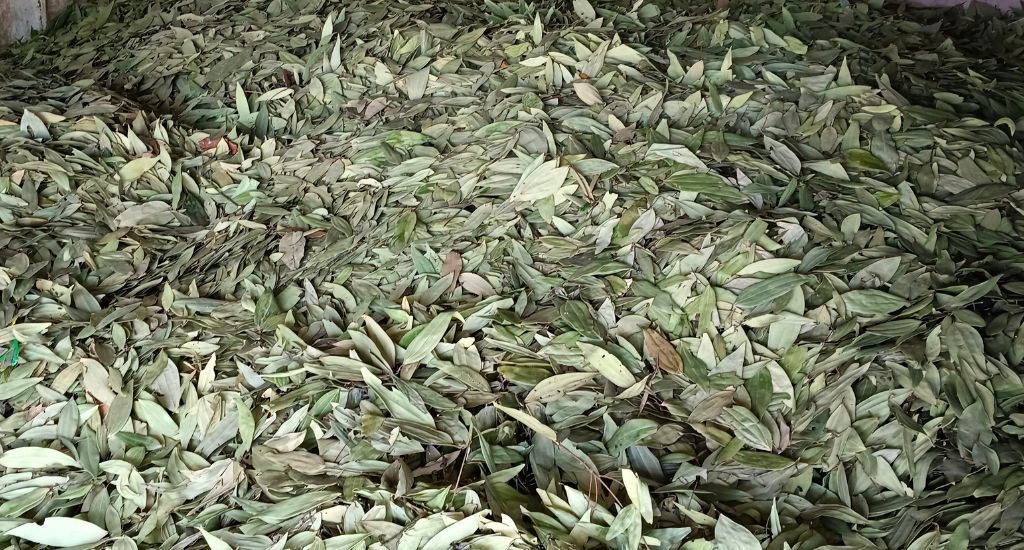Lalita Rai’s job is to separate the leaves of the Indian bay leaf tree (Cinnamomum tamala) from the twigs. Her work at Gondoljot village in Darjeeling district of West Bengal will bring aroma to different delicacies prepared in distant places she may not have heard of.
Rai, 25, earns around Rs 1,200 per week after working for 7-8 hours per day. It’s this income that sends her six-year-old son to school.

“My husband works as a labourer and plucks the sprigs from the trees. I separate the leaves from the stem. We live in poverty but my income helps with family expenses and my son’s education,” she said.
Bay leaves offer livelihood
The bay leaf, commonly known as tejpatta, is an aromatic leaf used in dishes to add flavour and can be used either dried or fresh.
Bay leaves provide livelihood to nearly 10,000 women in Darjeeling, Jalpaiguri and Cooch Behar districts in the northern parts of Bengal. Women are mostly involved in separating the leaves from the twigs and drying them under the sun. The dried leaves are sold to traders who pack and dispatch them to other places in India and abroad.
Also Read | The disappearing wild orchids of North Bengal
“It usually takes a day to dry the leaves under the scorching sun but can take longer if the sky is cloudy,” said Nina Burman, 30, a worker in Chanajot village.

The six-member family of 32-year-old Sunita Rai, a resident of Gandaljot village, that is located barely one kilometre from the India-Nepal border, survives on her income.
“My husband works as a labourer but his income is barely enough to run the household. The bay leaf work helps me handle the family expenses,” she said.
Supplying across India and beyond
Bharat Rai, 48, a local trader involved in the business said that farmers take the trees on lease from plantation owners for a season.
“The trees are leased for a fixed amount. With their experience, the farmers easily gauge the likely production and fix the rate accordingly,” he said.
Also Read | Novel elephant alarm: Bengal villagers turn to the bottle
The process of harvesting leaves can begin three years after the tree is planted and can be done for at least 25 years. Trees are usually pruned once or twice annually to boost production. Each tree can produce 15-20 kg of leaves or more if they are old.
“With fertilisers and water, the plant can survive for a longer period. It is a profitable crop,” said Rai.
The leaves are categorised depending upon their quality.

“The leaves which are clean and whole are sold at higher prices than those that are broken,” said Pankaj Kumar, who supplies bay leaves.
“They are packed in bags and dispatched to wholesalers in different parts of the country and even abroad. We have huge demand from places where non-vegetarian dishes like biryani are cooked,” he added.
Impact of climate change
Traders say climate change has been hitting the bay leaf business. Farmers also have to bear damage caused to the crop by natural disasters or other reasons.
“Normally, we need 5-6 months of rain to have a good production of leaves. But rains have become erratic and less because of climate change. Now it rains only for 2-3 months which is leading to the spread of various diseases and insect infestation in the plants,” said Nitu Singh, a bay leaf trader.

Amrendra Pandey, technical officer at the Department of Biotechnology, University of North Bengal, said that bay leaf trees are also used to provide shade to tea plants to protect them from the scorching heat of the sun.
Also Read | The sweet success of a tea plucker-turned-dragon fruit farmer
“The intercropping brings dual income to the farmers. Bay leaves remain in high demand. Besides its extensive ulitisation in cooking, the leaf is also used for extracting essential oil,” he said, adding that a proper study needs to be done to find the exact cause and extent of damage to bay leaves due to climate change.
The lead image at the top shows bay leaves getting dried in the sun (Photo by Gurvinder Singh)
Gurvinder Singh is a journalist based in Kolkata.
Edited by Village Square content team.








